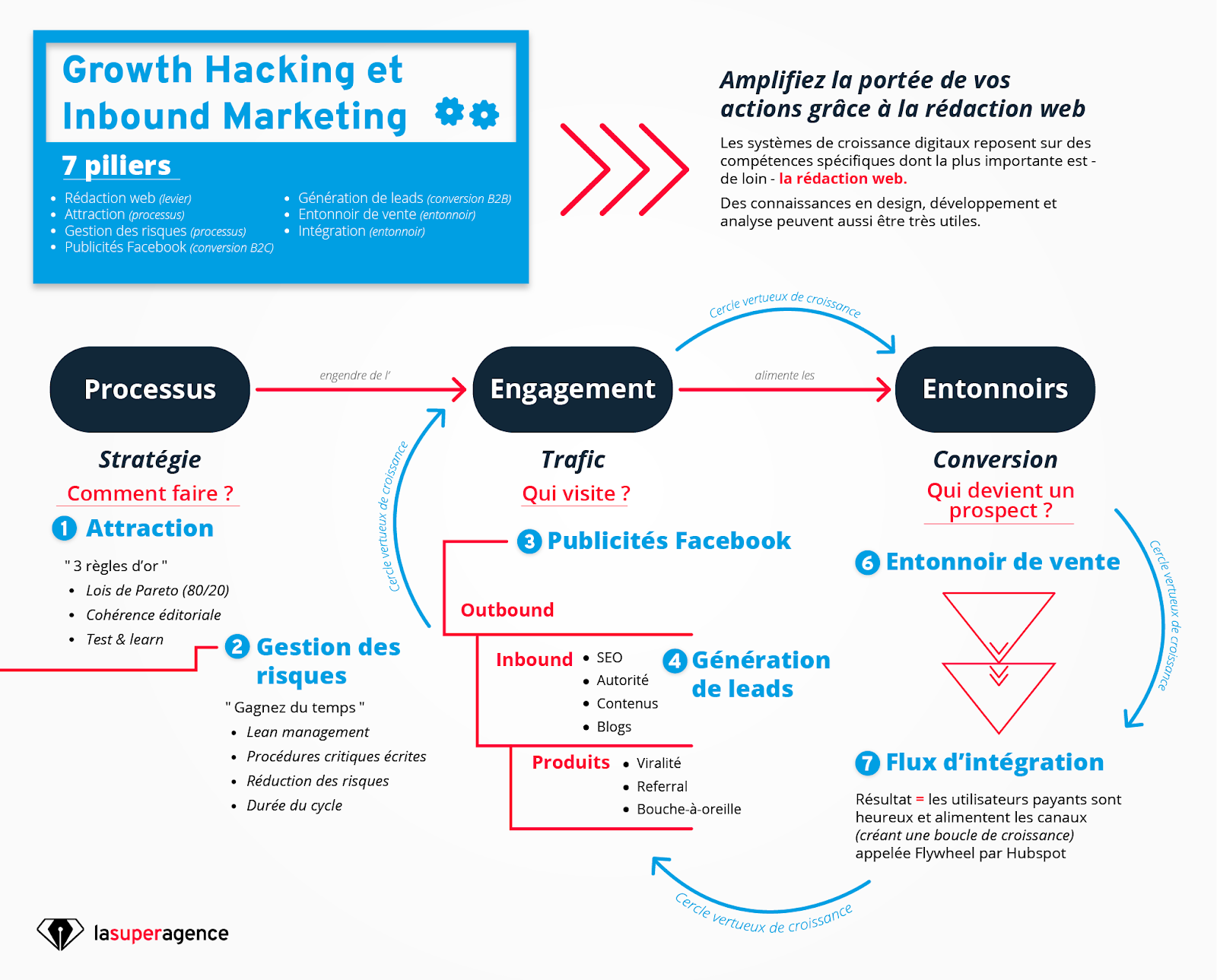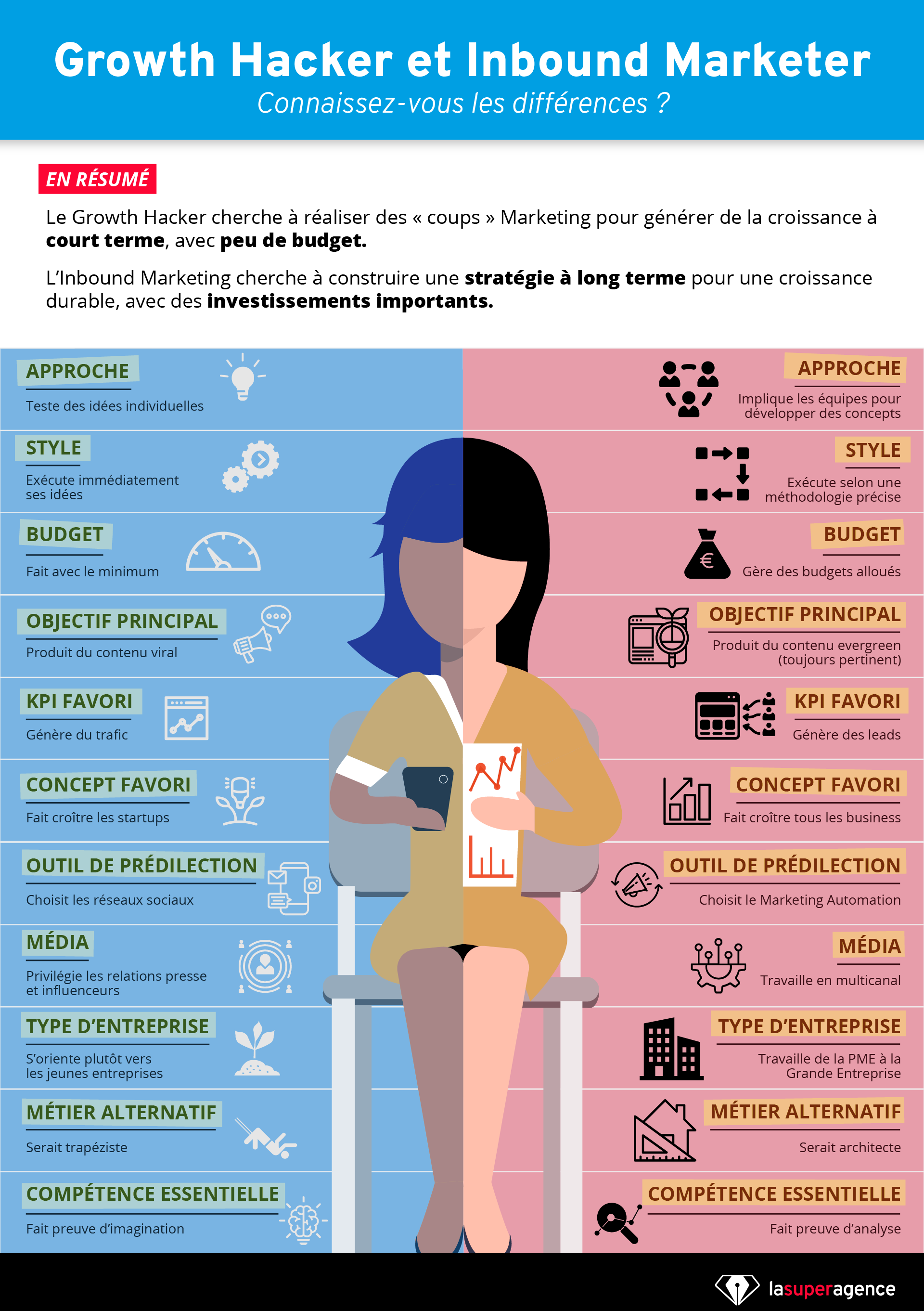Growth Hacking is a set of Marketing tactics with the goal of rapid growth with a minimum budget.
The goal is to gain customers as quickly as possible (to accomplish the famous "start up": ultra-fast growth) through control of customer data, tracking it and using the latest technologies.
It was startups first, then, especially B2C e-services companies, that used Growth Hacking to generate rapid growth. These include Airbnb, Facebook, Dropbox, Groupon, Instagram, or LinkedIn have become major digital players thanks to a wise use of Growth Hacking tactics.

Growth Hacking is a set of tactics to generate rapid growth
1 - What is Growth Hacking
Growth Hacking is about identifying user needs and wants in order to meet them first, at the lowest cost and in the most rapid way possible.
This process helps to fidelize its community and attract ever more new customers.
A concrete example of "growth hacking" is the idea of Hotmail, an early email provider that offered free email services to its users, enticing 20,000 people to sign up.
It took the opportunity to add messages to advertise its product such as "Get your free email from Hotmail" at the end of every email its existing customers sent.
Thanks to this trick, the company was able to promote - at a lower cost - its product to their friends and family. This allowed it to get 3,000 new users a day, and reach the million user mark after six months.
Later, Dropbox employed the same strategy successfully.
However, this technique should not be confused with the desire to be visible: Growth Hacking is not about buzz but about aiming for "quick wins", quick successes to boost growth. In reality, while buzz can be a consequence of a growth hacking tactic, growth hacking techniques are about generating new customers in a much more direct way.
Growth Hacking, if used properly, can therefore trigger strong growth for a startup.
However, we can't talk about a real strategy but rather a gas pedal shot. How to make the results of Growth Hacking tools sustainable?
For a company, it is more relevant to focus on intense, steady and sustainable growth rather than one-off spikes.
2 - What are the links between Growth Hacking and Inbound Marketing?
Growth Hacking has spawned, more or less empirically, the methodology of Inbound Marketing.
In fact, in 2006, two brilliant MIT students, Brian Halligan and Dharmesh Shah, had the idea of synthesizing all the best Digital Marketing techniques and making them accessible via a single platform.
That's how Hubspot and Inbound Marketing were born!
The inbound marketing has the primary goal of getting customers to come to you spontaneously rather than going to them. At the end of the process, it can turn a company's customers into true ambassadors for its brand and products.
These are not tactics to be applied at a moment T but a real strategy to increase the company's growth in the long term.
If it comes from the observation of Growth Hacking, Inbound Marketing goes even further by proposing a long-term approach to generate customers as shown in this diagram:

Growth Hacking tactics are integrated into the Inbound strategy
Inbound marketing holds both sales and marketing activities, often via an alignment of the two teams, which seek linear and sustainable growth over time via a lead nurturing process.
Can we then make good use of "hacks" in an Inbound strategy?
The key to success is to ensure that Growth tactics are perfectly aligned with Inbound strategies. The focus should be on generating qualified leads above all else. Quality always trumps quantity!
3 - How to optimize Growth tactics for your Inbound strategy

Infographics of the different tools of both methods
Many of the tools of Growth Hacking can be used wisely to develop a long-term Inbound Marketing strategy.
Improve your user experience with A/B testing
This popular marketing technique involves comparing two versions of a web page or website to see which one performs better. Through A/B testing, it is possible to know which version gets more traffic, better conversion rate, more subscriptions, etc.
.Then it's easy to know what influences visitor behavior and therefore improve the customer experience, and revenue at the same time.
Make yourself indispensable with quality content
Publishing content regularly on a site or blog allows you to spark the interest of potential customers, but also to foster customer loyalty by offering advice. To be effective, this content must provide value and address consumer needs.
Creating and maintaining a blog allows for regular and ongoing distribution of qualitative content. It is also possible to offer customers and prospects more in-depth guides and articles as downloadable PDFs in exchange for their email address. This is a great way to quickly grow your contact list.
Testing different themes and topics like a Growth Hacker to find the pitches and keywords that will most resonate with your target audience.
The lead nurturing to maintain a strong connection with your prospects
This is a process of maintaining or strengthening a marketing relationship with prospects (leads) who are not yet willing to become buyers. The idea is to regularly send quality content with the long-term goal of turning them into customers.
Your customers are your best marketers with social proof
As a general rule,an individual is strongly influenced by the behavior and opinion of the many. For example, a restaurant or bar is often chosen for its crowded room. It's the same with online retail. 88% of consumers read online reviews and recommendations before buying.
Growth regularly uses this social proof that allows a startup to gain credibility and grow its community.
Work on your SEO and CRO to maximize your growth
SEO (Search Engin Optimization) is not specifically related to Growth Hacking, but its use is almost mandatory because it allows you to optimize a website in order to attract the most traffic. It is one of the keys (the main one) to make the efforts undertaken to create quality content profitable.
In the same way, taking care of your CRO(Conversion Rate Optimization) is essential because converting a visitor into qualified leads allows you to increase your customer base in the long run.
At the end of the day, you have to think of Growth Hacking as a set of tactics that can generate revenue quickly. By combining just the right amount of these techniques in a way that aims for the long term and sustainable growth, we then get the outline of an Inbound Marketing strategy.
So, one can consider the birth of Inbound Marketing to be a direct consequence of the rise of Growth Hacking.








